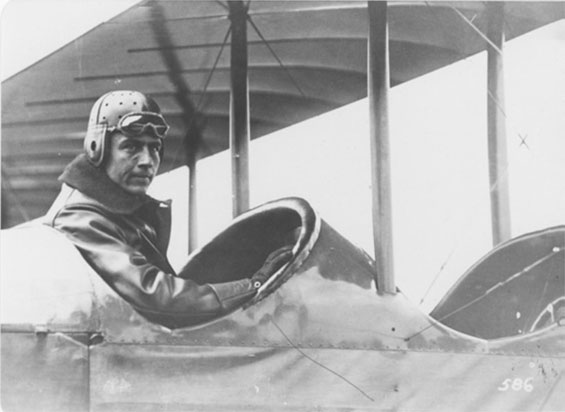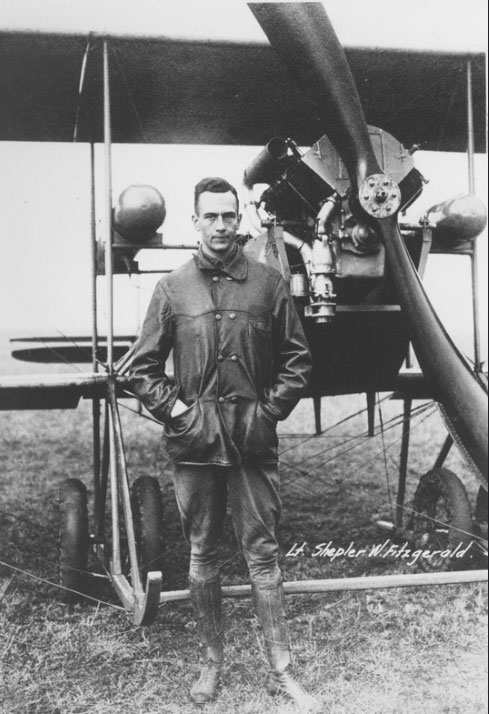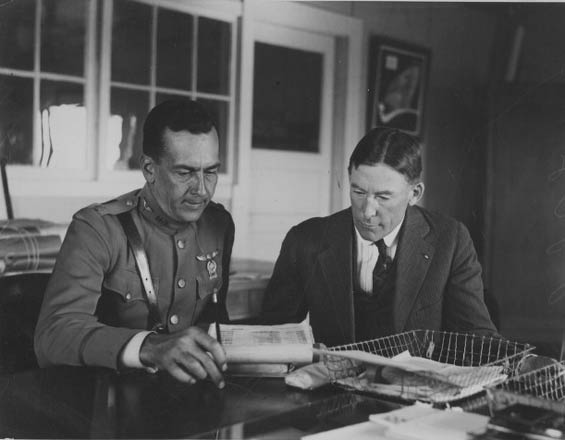|
Shepler FitzGerald landed once at Tucson, Friday, December 7, 1928 at 2:30PM. He was solo in Douglas 29-183. Based at San Antonio, TX, Brooks Field, he was eastbound from San Diego, CA, Rockwell Field and remained overnight at Tucson. He departed next day at 3:00PM eastbound for San Antonio. It is unusual that a pilot would discontinue flying so early and continue so late the next day. Perhaps he had trouble with his machine, or the weather at that time of year was not cooperating. Below, courtesy of the San Diego Aerospace Museum Flickr Stream (SDAM), is a photograph of FitzGerald in flight gear. From the looks of the gear, the picture was snapped sometime during the 1920s.
S.W. FitzGerald, Date & Location Unknown (Source: SDAM)
 |
FitzGerald has a more or less complete biography through 1942 in his NASM biographical file (cited left sidebar; no photographs). He was born in Burden, KS on November 11, 1884. As such, he was one of the oldest pilots (44) to land at Tucson during the time the Airfield Register lay open on the desk there. A photograph of Shepler is at the link for the Early Aviators site. He has a good Web presence, but be careful with your exploration, because he had a son of the same name born in 1918 (d. March, 2011) that also shows up in searches.
FitzGerald received a Bachelor of Laws degree from George Washington University, Washington, DC in 1907. He joined the Army in 1912 as a second lieutenant in the Coast Artillery Corps. He was promoted more or less regularly over the next 30 years. Initially to first lieutenant on July 1, 1916, captain on May 15, 1917 and to lieutenant colonel on August 14, 1918 (temporary). He reverted to his permanent rank of captain on on March 29, 1920 and was promoted to major on July 1, 1920. He visited Tucson between then and when he was promoted to lieutenant colonel on August 1, 1935. He was promoted to colonel February 1, 1941 and to Brigadier General on April 16, 1942.
In October, 1914, FitzGerald was detailed to the Signal Corps and assigned to the Aviation School at North island, San Diego, CA. He was learning to fly and was almost immediately awarded the Mackay Trophy for 1914 for the most meritorious flight of the year. Flying a Burgess aircraft with captain Townsend F. Dodd (who was probably pilot-in-command), the two made a reconnaissance flight on December 23, 1914 from Los Angeles, CA, via Santa Ana, Capistrano and Oceanside, to Delmar, CA, thence to North Island. The take-off from Los Angeles was made at 9:44 AM; the landing at North Island at 1:01PM. A relatively simple flight today, even in Los Angeles flight space. But don't forget, this was 1914.
In June, 1915, FitzGerald graduated as a Junior Military Aviator and ordered to the 1st Aviation Squadron at For Sill, OK. He returned to San Diego in November and in March, 1916 proceeded to the Philippine Islands, where he served with the 2nd Aero Squadron until June, 1916. He returned to the United States after three months and was assigned to the John Hays Hammond Laboratory for experiments with pontoon equipment.
In December, 1916 he was assigned to flying duty at Mineola, Long Island, NY, and in July, 1917 was ordered to Toronto, Canada where he commanded a detachment of American flying students undergoing instruction at the Royal Flying School. He then went to Mount Clemens, MI (Selfrige Field) for training. Below, from the SDAM, is another undated photograph of Fitzgerald, probably during this period.
S.W. FitzGerald, Date & Location Unknown (Source: SDAM)
 |
He sailed for France with the 2nd Provisional Wing of the Air Service on December 4, 1917 and upon arrival was assigned to the Training Section of the Headquarters Air Service in Paris. He spent the first three months of 1918 on temporary duty in England. He returned to France for training and flying duty at Tours and Issoudon until April 29, 1918.
He then took over as Director of the 2nd Corps Aeronautical School at Chatillon-sur-Seine and of the second Aviation Instruction School at the Observation Center at Tours. He later was Air Service Commander of the 1st Army and was commended by the Chief of the Air Service, AEF, for exceptional services.
Upon his return to the U.S. in May, 1919, he was assigned to duty in the Supply Group, Office of the Director of Air Service, Washington, DC, and also served as a member of the Joint Army and Navy Board on Aeronautics. In September, 1919 he became Assistant to the Executive, Office of the Director of Air Service. In July, 1920 he was transferred to Rockwell Field in charge of the Aviation Supply and Repair Depot.
In October, 1922 he became Executive Officer and Director of Attack Training at Kelly Field, TX and served as such until February, 1925. He then attended the Army Industrial College, Washington, DC, and following graduation was assigned to the Office of the Chief of Air Corps. In June, 1927 he was made Commanding Officer of the Air Corps Primary Flying School at Brooks Field. He retained that command until August, 1930. It was during his tenure in that position that we meet him at Tucson, December 7, 1928.
In August, 1930 he enrolled in the Air Corps Tactical School at Langley Field, VA and was graduated in June, 1931. He then attended the Army War College and was graduated with the class of 1932. He then proceeded to the Rockwell Air Depot, which he commanded until November, 1934. He was then ordered to Washington, DC again for duty as Assistant to the Chief of Construction, Supply Division, War Department General Staff.
Below, courtesy of the Hagley Museum, is a circa 1930s photograph of FitzGerald on the left with Register pilot Frank Lahm. The image ID is 75360_00522.tif.
Shepler W. FitzGerald (L) With Frank Lahm, Ca. 1930s (Source: Hagley Museum)
 |
Information on the back of this Hagley image states, "Plans for sending 934 men, 166 officers and 68 planes to Rockwell Field, San Diego, and thereby establishing a big west coast aerial operations base are being considered by the war department, it is reported. The men in question are the Third Attack Group of the Air Service. If they are sent to Rockwell Field, that famous base will be restored to its war time status and personnel and will be one of the most strategic military airports in the world. This picture shows Col. Frank Lahm, commanding the 9th Corps Area of the Air Service, and Maj. Shepler W. Fitzgerald, commander of Rockwell Field, conferring on the plans." His position as commander at Rockwell dates this photograph sometime between 1932 and 1934 (See below).
In September, 1938 then lieutenant colonel FitzGerald was assigned to command of Luke Field, T.H., and in July , 1939 became Air Base Commander at Hickam Field, T.H. He returned from Hawaii on August 7, 1940 and was assigned to duty with the 5th Air Base Group at Fort Douglas, Salt Lake City, UT. On February 13, 1941 he was assigned to the Inspector General's Department in Washington, DC. Following his promotion to Brigadier General on April 16, 1942, he was assigned to duty with the Headquarters Army Air Forces, Washington, DC. On June 3, 1942 he was assigned to the Air Corps Ferrying Command. Shortly thereafter he was transferred to duty in Africa as commander of both the Africa-Middle East Wing and a new theater command, United States Army Forces in Central Africa. His headquarters, wing and theater, were established first at Cairo, but were soon moved to Accra, the permanent location. There he began the militarization of Pan American's contract operations in Africa, an undertaking that required about six months to complete.
In late 1942, the Army expanded its presence in Accra by activating the 12th Ferrying Group Headquarters, the 41st Ferrying Squadron, and the 42nd Ferrying Squadron. The 12th Ferrying Group, which was part of a transportation network reaching from the U.S., via Africa, to the China-Burma-India theater of operations, ensured the movement of men and matériel through Senegal, Ghana, and Chad.
FitzGerald died about ten years later January 10, 1953 at age 68. I have no information about his activities during that decade. Does anyone KNOW?
---o0o---
THIS PAGE UPLOADED: 06/29/11 REVISED: 11/28/14
|




